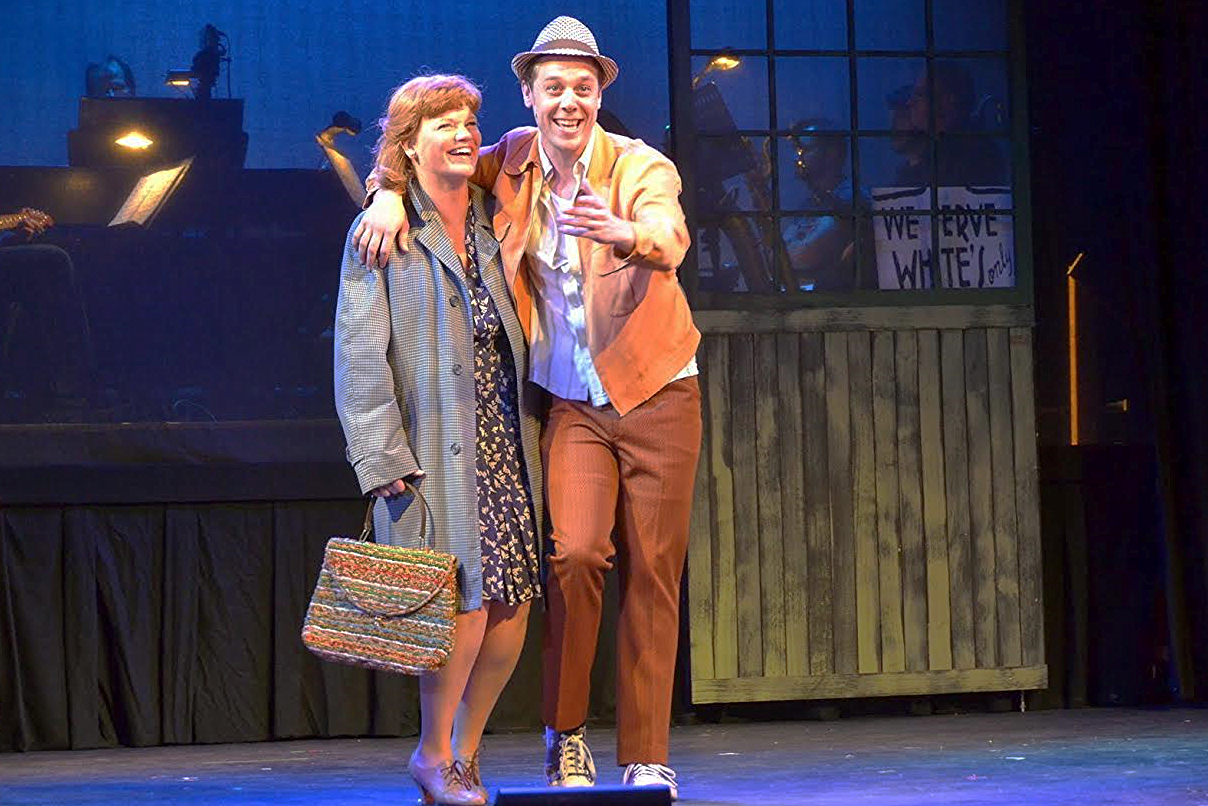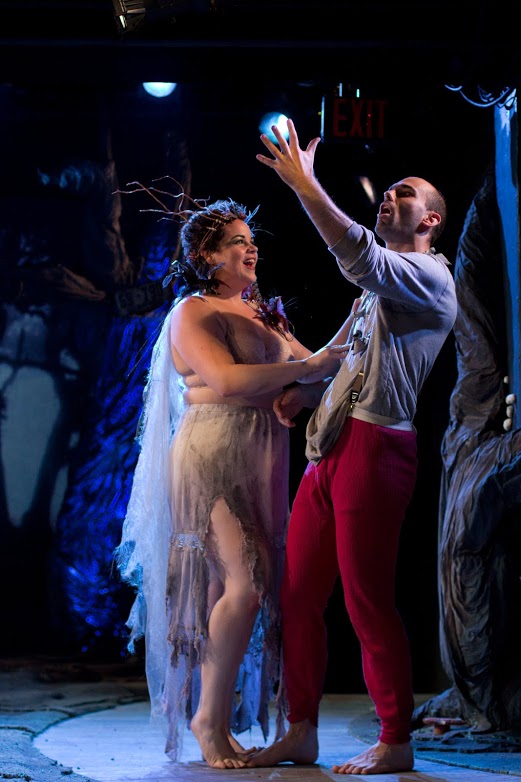Review of An Opening in Time at Hartford Stage
“The purpose of playing,” Hamlet says, “is to hold as ‘twere the mirror up to nature.” A statement that might lend itself to a support of realism in theater, so that what happens onstage should be very much like what happens in real life. That argument works as a rationale for mimetic works that are based on real people, real places.
In Christopher Shinn’s An Opening in Time, the intention to portray his hometown—Wethersfield, Connecticut—as it was in his youth creates a play that will certainly resonate with local audiences who will recognize place-names and appreciate how deliberately the dialogue recreates the tentative, non-emphatic speech of people accustomed to a certain pace of life. There is a pervasive small town feel to the play—which includes scenes in a local diner and in a Denny's and in a homey farmhouse kitchen—and that helps to sell the small talk that sometimes sounds exactly like real life, which is to say, not really very interesting.
Deborah Hedwall (Anne)
Anne (Deborah Hedwall), a middle-aged woman recently widowed, returns to Wethersfield after selling off the farm to which she, her husband, and their young son had moved about thirty years before. Nothing much has changed in the riverside town, “Ye Most Auncient Towne in Connecticut,” according to its website. We meet Anne first when the boy next door, George (Brandon Smalls), hits her door with a baseball which sets up her neighborly attempt to get to know him. Anne is a retired schoolteacher so that justifies her somewhat needy interest in the young man. Later, we learn she is having problems with her own adult son, due in part to his status as a sex offender (also a teacher, he had an affair with one of his underage students).
George, it turns out, is living with foster parents and there are odd tensions surfacing as Kim (Molly Camp), the mother, at first reaches out to Anne and then seems to avoid her. Or at least that’s how Anne sees it. Meanwhile, Ron (Patrick Clear), who spends most mornings and evenings at the same diner in the same chair at the counter, often trading familiar jibes with Frank (Bill Christ), notices on his friend’s iPad that Anne, with whom he obviously has history, has bought a house in town. Not much more occurs in the first act except someone unknown—George? Anne’s son?—is breaking Anne's kitchen windows when she’s not at home. Ron and Anne take very tentative steps toward one another, sharing one of her pies, meeting for lunch and then . . . nothing.
George (Brandon Smalls), Anne (Deborah Hedwall)
Shinn seems to have learned from Chekhov the technique of using an entire act to establish the main narrative lines, that will then alter through significant changes in the later acts. But that’s where the comparison ends. The subplots that drift through the story of Anne and Ron don’t have any urgency, not even the fact that George is on his way to becoming transgender. And whatever’s up with Kim plays out in a few scenes of awkward forced neighborliness. Meanwhile, the story of Sam (Karl Miller), Anne’s son, becomes little more than an occasion for Anne to try to get back to some kind of emotional balance.
What Shinn gets convincingly right occurs in the second act when Ron and Anne finally have it out about who remembers what about the time, right before she left town with her family, when he came to her house to let her know how he felt about her. It was an intense evening, full of feeling that, in memory, has become a failed turning point for each, something they both blame the other for. The scene, with its grasp of how people with grudges who cared for each other and would like to continue doing so can spar, catches fire and shows us how, beneath all that simple, everyday chatter, there are real passions and regrets and resentments. And the focus of the interplay between Hedwall and Clear, as they let us into what’s really going on inside these average, unassuming types, has real impact, making the other currents in the story seem force-fed into the tale.
Directed by Oliver Butler, who has shown great facility with Will Eno’s precise and hilariously gnomic version of dysfunctional family life in Open House, as well as a grasp of the scurrilous barbs of a family in each other’s faces in Bad Jews (at the Long Wharf last season), shows a softer, more easygoing side here. The heat between Hedwall and Clear certainly shows his touch, but that’s not enough to make Hedwall’s scenes with Camp and Smalls work.
Antje Ellerman’s wonderful set, showing the classic lines of Connecticut homes adorned with bare trees and artful lighting from Russell H. Champa, urges us to feel the autumnal air that surrounds these characters, but doesn’t do so well when it has to switch to a diner or a Denny’s. With booths and counters rising up from below through trapdoors, only to sink again when not needed, the briskness of the transitions distracts from the dialogue’s deliberate pacing and seems almost a joke at its expense. Or maybe that’s a way of saying that, hoping for something that will interest or amuse, one finds it as one can.
Anne (Deborah Hedwall), Ron (Patrick Clear)
Shinn gets intentional laughs from jibes at Rent—Ron is a semi-retired schoolteacher who puts on the school’s big musical each year and grumbles about Rent as the show the kids want and he doesn’t. Whether Shinn shares any of Ron’s feelings about the popular pseudo-gritty musical, An Opening in Time does allow that, for someone like George, Rent might be a glimpse of a world he needs to know more than he needs a book of Hemingway stories or mollycoddling from Anne.
As Anne, Deborah Hedwall has a wavery voice that cracks with feeling; she speaks like a woman who has made her living talking and is trying to find a way, now, to speak about herself and her feelings. Patrick Clear’s Ron is likeable and very natural, a good neighbor type whom no one would accuse of being an exciting catch. As Frank, Bill Christ adds some male camaraderie where it’s needed. The other parts—a policeman (Mike Keller), a surly Polish waitress (Kati Brazda), George and his mother—come and go without becoming more than sidelights. As Anne’s uneasily guilty thirtysomething son, Karl Miller’s Sam seems bemused at his mother’s attempt to stay connected to him, while the actual logistics of their previous life are hard to fathom from their scene together.
Ron (Patrick Clear), Frank (Bill Christ)
A play of bits and pieces, An Opening in Time needs perhaps more time to find its opening toward a more fully resonant and rewarding slice of Connecticut life.
An Opening in Time
By Christopher Shinn
Directed by Oliver Butler
Scenic Design: Antje Ellerman; Costume Design: Ilona Somogyi; Lighting Design: Russell H. Champa; Original Music & Sound Design: Jane Shaw; Vocal Coach: Robert H. Davis; Casting: Binder Casting; Production Stage Manager: Cole P. Bonenberger; Assistant Stage Manager: Arielle Goldstein; Dramaturg: Elizabeth Williamson; Production Manager: Bryan T. Holcombe; Associate Artistic Director: Elizabeth Williamson
Cast: Deborah Hedwall; Brandon Smalls; Patrick Clear; Kati Brazda; Bill Christ; Molly Camp; Mike Keller; Karl Miller
Hartford Stage
September 25-October 11, 2015


















































